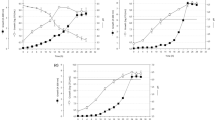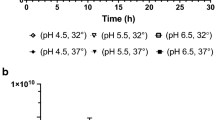Abstract
As the concentration step is usually considered to be responsible for cell damage, the objective of this work was to quantify the effect of centrifugation conditions (speed, duration, temperature, and pH) on the quality of Lactobacillus bulgaricus CFL1 starters. These effects were analyzed on the specific acidification activity of the cells, according to experimental designs. It is surprising to note that centrifugation conditions did not significantly affect the loss of specific acidification activity during the concentration step. In contrast, centrifugation speed and duration slightly altered cell resistance to freezing and frozen storage. No difference was observed when centrifugation was conducted at 4 or 15 °C. Finally, combining good centrifugation conditions to an acidification of the cells in their fermented broth strongly improved their cryotolerance. These results may have an impact for industrial starter production as they allowed modifying centrifugation conditions to better match the specificity and the viscosity of the medium.


Similar content being viewed by others
References
Bâati, L., Fabre-Gea, C., Auriol, D., & Blanc, P. J. (2000). Study of the cryotolerance of Lactobacillus acidophilus: Effect of culture and freezing conditions on the viability and cellular protein levels. International Journal of Food Microbiology, 59(3), 241–247.
Béal, C., Marin, M., Fontaine, E., Fonseca, F., & Obert, J. P. (2008). Production and preservation of lactic and probiotic starters. In G. Corrieu, & F.-M. Luquet (Eds.) Bactéries lactiques, de la génétique aux ferments (pp. 661–785). Paris, France: Tec&Doc Lavoisier.
Boyaval, P. (1992). Couplage fermentation–ultrafiltration et production de biomasse. Industries Alimentaires et Agricoles, 109(10), 713–716.
Bozoğlu, T. F., Ozilgen, M., & Bakir, U. (1987). Survival kinetics of lactic acid starter cultures during and after freeze drying. Enzyme and Microbial Technology, 9, 531–537.
Carvalho, A. S., Silva, J., Ho, P., Teixeira, P., Malcata, F. X., & Gibbs, P. (2003). Impedimetric method for estimating the residual activity of freeze-dried Lactobacillus delbrueckii ssp. bulgaricus. International Dairy Journal, 13(6), 463–468.
Carvalho, A. S., Silva, J., Ho, P., Teixeira, P., Malcata, F. X., & Gibbs, P. (2004). Relevant factors for the preparation of freeze-dried lactic acid bacteria. International Dairy Journal, 14(10), 835–847.
Champagne, C. P., & Gardner, N. J. (2002). Effect of process parameters on the production and drying of Leuconostoc mesenteroides cultures. Journal of Industrial Microbiology and Biotechnology, 28(5), 291–296.
Corrieu, G., Spinnler, H. E., Jomier, Y., & Picque, D. (1988). Automated system to follow up and control the acidification activity of lactic acid starters. French Patent no. 2 629 612 (in French).
Fonseca, F., Béal, C., & Corrieu, G. (2001). Operating conditions that affect the resistance of lactic acid bacteria to freezing and frozen storage. Cryobiology, 43(3), 189–198.
Mäyrä-Mäkinen, A., & Bigret, M. (1998). Industrial use and production of lactic acid bacteria. In S. Salminen, & Av. Wright (Eds.) Lactic acid bacteria: Microbiology and functional aspects (pp. 73–102). New York: Marcel Dekker.
Saarela, M., Virkajärki, I., Alakomi, H.-L., Mattila-Sandholm, T., Vaari, A., Suomalainen, T., & Mättö, J. (2005). Influence of fermentation time, cryoprotectant and neutralization of cell concentrate on freeze-drying survival, storage stability, and acid and bile exposure of Bifidobacterium animalis ssp. lactis cells produced without milk-based ingredients. Journal of Applied Microbiology, 99, 1330–1339.
Streit, F., Corrieu, G., & Béal, C. (2007). Acidification of fermented broth improves cryotolerance of Lactobacillus delbrueckii subsp. bulgaricus CFL1. Journal of Biotechnology, 128(3), 659–667.
Wang, Y., Corrieu, G., & Béal, C. (2005a). Fermentation pH and temperature influence the cryotolerance of Lactobacillus acidophilus RD758. Journal of Dairy Science, 88(1), 21–29.
Wang, Y., Delettre, J., Guillot, A., Corrieu, G., & Béal, C. (2005b). Influence of cooling temperature and duration on cold adaptation of Lactobacillus acidophilus RD758. Cryobiology, 50(3), 294–307.
Acknowledgments
This work was partially supported by the CAPES Foundation (Brazil). The authors would like to thanks Dr. Anne Saint-Eve for her help on the statistical analysis of our results.
Author information
Authors and Affiliations
Corresponding author
Rights and permissions
About this article
Cite this article
Streit, F., Corrieu, G. & Béal, C. Effect of Centrifugation Conditions on the Cryotolerance of Lactobacillus bulgaricus CFL1. Food Bioprocess Technol 3, 36–42 (2010). https://doi.org/10.1007/s11947-008-0067-9
Received:
Accepted:
Published:
Issue Date:
DOI: https://doi.org/10.1007/s11947-008-0067-9




